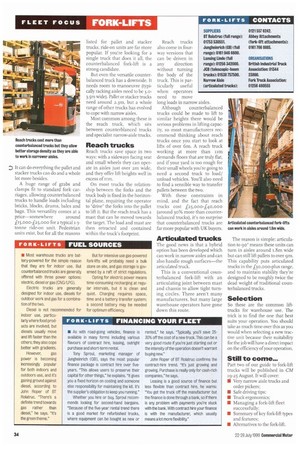FORK-LIFTS FUEL SOURCES
Page 36

If you've noticed an error in this article please click here to report it so we can fix it.
• Most warehouse trucks are battery-powered for the simple reason that they are for indoor use. But counterbalanced trucks are generally offered with three power options: electric, diesel or gas (CNG/LPG).
Electric trucks are generally designed for indoor use, diesels for outdoor work and gas for a combination of the two, Diesel is not recommended for indoor use, particularly where food products are involved, but diesels usually move and lift faster than the ethers; they also cope better with gradients.
However, gas power is becoming increasingly popular for both indoors and outdoors use, and it's gaining ground against diesel, according to John Roper of BT Rolatruc. "There's a definite trend towards gas rather than diesel," he says. "Ifs the green theme." But for intensive use gas-powered fork-lifts will probably need a bulk store on site, and gas storage is governed by a raft of strict regulations.
Opting for electric power means time-consuming recharging at regular intervals, but it is clean and quiet. Charging requires space, time and a battery transfer system; a second battery may be needed for optimum efficiency.








































































































